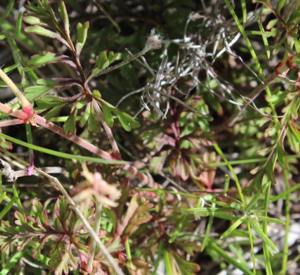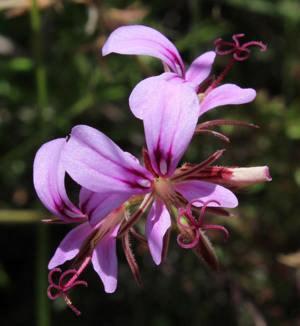Pelargonium multicaule
Pelargonium multicaule Jacq.
Family: Geraniaceae
Common names:
Introduction
A beautiful sprawling pelargonium with dark pink flowers, ideal for hanging baskets as well as a good ground cover.
Description
Description
Pelargonium multicaule is a well branched decumbent herbaceous perennial, 0.30 m high and 1 m in diameter. The herbaceous stems are smooth but woody at the base, trailing, often angular, with glandular hairs and a few long hairs interspersed. These hairs are green but sometimes flushed with red, turning greyish brown as the stems get older. The hairless leaves are irregularly pinnately to bipinnately incised.

Three to five dark pinkish to purple flowers are borne on an unbranched peduncle. The flowers, 25 mm in diameter, have four petals each, the posterior (upper) two are larger and decorated with purple markings with a white mark near the base. This species flowers throughout the year with a peak in October to December. It can be abundant after fire or in disturbed loamy soils in Renosterveld, Fynbos, and Waboomveld.
Conservation Status
Status
Pelargonium multicaule is listed on the National Red List of South African plants as Least Concern (assessed February 2009).
Distribution and habitat
Distribution description
Pelargonium multicaule has a wide distribution range. It occurs from the southern and eastern parts of the Western Cape Province to as far north as the district of Maseru in Lesotho. It is very common in the Langkloof and especially in the area of Grahamstown in the Eastern Cape. It is therefore found both in the winter- and summer-rainfall regions. The annual rainfall is relatively low in both regions. This pelargonium is mostly found growing in mountainous habitats with well-drained soil.
Derivation of name and historical aspects
History
William Henry Harvey, an Irish botanist, divided the pelargoniums into 15 sections. The diagnostic features for the different divisions were based on leaf and flower characteristics and habitat. Pelargonium multicaule is classified under the section Myrrhidium which consists of herbaceous annuals and perennial half-shrubs with diffuse and slender stems. Their leaves are pinnately divided. The flowers have four or five petals with the upper two being larger.
Pelargonium multicaule belongs in the family Geraniaceae, a large family of 11 genera and 800 species in subtropical and temperate regions of the world. The South African genera in the Geraniaceae family are Monsonia, Sarcocaulon, Pelargonium, Erodium and Geranium.
There are approximately 270 species of Pelargonium which occur in S, E and NE Africa, Asia, St Helena, Tristan da Cunha, Madagascar, Australia and New Zealand, most of which (± 270 species) occur in southern Africa with ± 150 species in fynbos. Pelargoniums are often wrongly called geraniums. Pelargonium gets its name from the resemblance of the shape of the fruit to the beak of a stork, which is pelargos in Greek. The epithet multicaule is derived from multi- (Latin), many, and caulis (Latin), stem, and refers to the much branched stems of this species.
Ecology
Ecology
Pelargonium seed is interesting in that, attached to the elliptic seed, is a feathered, tail-like structure that is coiled in a spiral arrangement. This tail causes the seed to twist around in the wind and drill itself into the soil in a corkscrew fashion, thus ensuring that most seeds (5 seeds per flower) have a good chance of germinating ( Brown, N. & Duncan, G. 2006).

Uses
Use
Pelargoniums are well known plants and have long been used in the horticultural industry for perfume and medicinal purposes. Pelargonium multicaule has no cultural use. It does have horticultural potential.
Growing Pelargonium multicaule
Grow
This species will do well in your garden provided there is good soil drainage. It is ideal for large hanging baskets. The stems are quite long and will produce beautiful pink flowers cascading from the basket. It can also be used in a sunny section of the garden as a groundcover because of the trailing growth habit. Please ensure that this section in your garden is large enough as the stems may cover an area 1 m in diameter.
Plant P. multicaule in an area where it will not be invasive among other shrubs or perennials. The plant can be pruned to keep it neat and tidy. According to Pooley (1998), it is a `Fast growing useful groundcover (dies back at the end of the growing season), from seed or cuttings.
Pelargonium multicaule can be propagated from cuttings and seed. Cuttings can be taken at any time of the year from healthy vigorous plants, from softwood or herbaceous growth, preferably after the flowering and seeding period. Apply a rooting hormone that will accelerate the rooting process, especially for the softwood cuttings. The cuttings are then placed in coarse river sand in cold frames and keep them moist. If you do not have a cold frame then a shaded area is also good with a bit of soft light. Direct hot sunlight is not recommended as this will scorch the cuttings while trying to root. The cuttings should root within 4 weeks. Give the rooted cuttings a 2-week weaning period and transplant them into a well-drained potting soil mix and place them in a sunny position. Once the plants have formed a strong root ball they can be planted out into the garden.
Pelargonium seeds are best sown fresh but can remain viable for up to seven years. Sow seeds in late summer to early autumn. The seed should be sown in a light, well-drained potting mix. Sprinkle the seeds evenly in the seed tray and cover them with fine-milled pine bark. Water the seeds gently but thoroughly with a fine-nozzled watering can and place them in light shade with no direct sun. Seed germinates within 3 weeks. Plants grown from seeds will flower within 12 to 18 months.
Pelargoniums grow very well outdoors free of any diseases, but if the same plant is grown indoors or in a greenhouse the warmer climatic conditions and lack of air circulation usually result in pests, such as mealy bug, aphids, white fly or rust and powdery mildew. Consult the nearest garden centre to find out what the latest and best suited pesticides and fungicides are for the problems.
Thanks to Tony Rebelo and the Ispot website for images.
References
- Brown, N. & Duncan, G. 2006. Grow fynbos plants. South African National Biodiversity Institute, Cape Town.
- Pooley, E. 1998. A field guide to wild flowers Kwazulu-Natal and the Eastern Region. Natal Flora Publications Trust, Durban.
- Van der Walt, J.J.A. 1977. Pelargoniums of southern Africa . Purnell, Cape Town.
- Van der Walt, J.J.A. & Vorster, P.J. 1981. Pelargoniums of southern Africa , vol. 2 . Juta, Cape Town.
- Vlok, J. & Schutte-Vlok, A.L. 2010. Plants of the Klein Karoo. Umdaus Press, South Africa.
- website: National Red List of South African plants (accessed February 2009). http://redlist.sanbi.org
Credits
Trevor Adams
Kirstenbosch National Botanical Garden
July 2013
Plant Attributes:
Plant Type: Shrub
SA Distribution: Eastern Cape, Free State, KwaZulu-Natal, Western Cape
Soil type: Sandy, Loam
Flowering season: Sporadic/All year
PH:
Flower colour: Purple, Pink, Mauve/Lilac
Aspect: Full Sun
Gardening skill: Average
Special Features:
Horticultural zones












Rate this article
Article well written and informative
Rate this plant
Is this an interesting plant?
Login to add your Comment
Back to topNot registered yet? Click here to register.